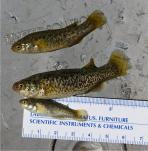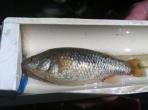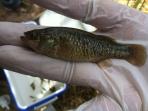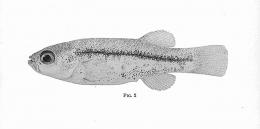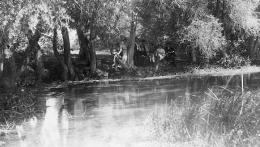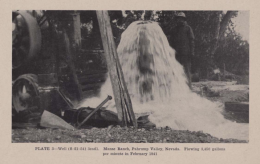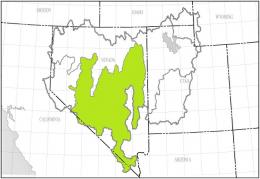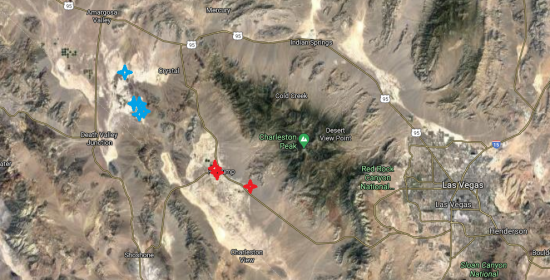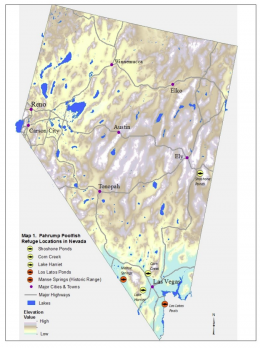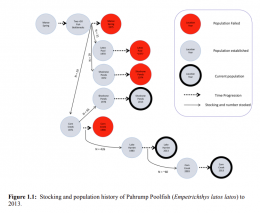Empetrichthys latos
MILLER, R. R. (1948): The cyprinodont fishes of the Death Valley system of eastern California and southwestern Nevada. Miscellanous Publications, Museum of Zoology, University of Michigan No.68: pp 1-155
Collection-number: University of Michigan Museum and Zoology, Cat. No. UMMZ-141855.
The Holotype is an adult female of 43mm standard length, collected by R. R. Miller and his wife Frances on October the 5th, 1942. Together with the Holotype, 143 Paratypes (originally UMMZ-140489), 15 to 48 mm long, and 34 Paratypes (UMMZ-132915), 10 to 50 mm long, collected by R. R. Miller and Alex J. Calhoun on July 16th, 1938, from the outlet of the main spring pool at Manse Ranch were taken.
The left picture shows a drawing of an immature male from Manse Spring, the right one an adult male Paratype (UMMZ-140489) of 34mm from the same locality. Concerning types of the other two described subspecies and pictures go to the chapter "Remarks":
The Holoype of this species was collected in the main spring pool on Manse Ranch, Pahrump Valley, Nye County, Nevada.
The left picture shows the main spring pool of Manse Ranch in the 1940's, the right one the output of the spring in 1941, which were impressive 3,450 Gallon per min (13,000 liters):
The species' name latos refers to the wide mouth of the species as compared to Empetrichthys merriami, the type species of this genus. The species epithet can be derived from Latin with "latus" meaning broad and "os" mouth, so together meaning "widemouth".
The genus was erected by Gilbert in 1893 and the generic name can be derived from the ancient Greek. The word ἔμπετρος (émpetros) means "into the rock" with the prefix ἔμ- (én) meaning into and πετρος (petros) the rock. The last part of the word ἰχθύς (íchthús, íchthýs) is the Greek word for fish, herewith the generic name can be translated with "fish that lives or hides in rocks".
Empetrichthys merriami Gilbert (partially), 1893
Empetrichthys latos was historically known from three springs being separated from each other by less than 12km beeline in the Pahrump Valley, Nye County, Nevada, namely Raycraft Ranch Spring, Pahrump Ranch Spring and Manse Spring (type locality). Water pumping in the second half of the 1950's drove the population of the Pahrump Ranch extinct while the Raycraft Ranch Spring was bulldozed and filled in 1955. The only remaining population from the Manse Ranch was relocated in the early 1970's to several introduction sites, when declining water levels due to groundwater pumping for agricultural development made the desiccation of Manse Spring predictable. Today, all known populations live outside of the native range of this species (for more information go to the chapter "Remarks").
ESU ist short for Evolutionarily Significant Unit. Each unit expresses an isolated population with different genetic characteristics within one species. ESU's can be defined by Molecular genetics, Morphology and/or Zoogeography and help in indicating different phylogenetic lineages within a species. The abbreviation for an ESU is composed of three letters of the genus, followed by the first two letters of the species name and an ongoing number in each species.
In the subfamily Empetrichyinae, no ESU's were in use so far. To align with the livebearing subfamily Goodeinae, the GWG wants to bring a system in use based on John Lyons' naming for this subfamily. According to morphological differences and the description of three subspecies, three ESU's ae recognized: Empla1 from the Raycraft Ranch (E. l. concavus) and Empla2 from the Pahrump Ranch (E. l. pahrump) have to be regarded extinct. The only ESU still existing, but inhabiting exclusively habitats outside of its natural range (Manse Ranch) is Empla3 (E. l. latos).
The left map shows the Central Nevada Desert Basins Accounting Unit (HUC 160600) of the Great Basin Region (HUC 16), the right map the Ivanpah-Pahrump Valleys Cataloging Unit (HUC 16060015). The names of watersheds here in use are the ones officially used by the the U.S. Geological Survey:
International Union for Conservation of Nature (IUCN): Critically Endangered
U.S. Fish & Wildlife Service (ECOS): Endangered
In the following lines, we give R. R. Miller the chance to describe himself the three springs where he was able to find the Pahrump Poolfish: "The main spring pool at Manse Ranch is about 50 feet (15.2m) wide at the head, 10 feet (3m) wide at the outlet, and 60 feet (18.3m) long. It is 1 to 6 feet (0.3 to 1.8m) deep and has a silt bottom. The water is crystal clear and chalky blue in a deep hole near the center of the spring. On October 5, 1942, vegetation noted was thick water cress, Chara, green algae, and a fine-leaved Potamogeton. The shore is a low bank, bordered by cottonwood (Populus fremonti?) and willow, which well shade the pool. The current is moderate in the pool and swift in the outlet. About 50 yards (45.7m) above is a much smaller spring which flows into the head of the pool just described; it contained no fish life. The temperature of the main spring, as recorded by several investigators over a period of 26 years, is very constant, about 24°C. (23.3 to 24.0°C). The 2 main springs on Pahrump Ranch, which rise about 200 yards (183m) east of the principal ranch houses, are used extensively for irrigation. Until recently the northern spring contained native fish life, but it was greatly altered by dredging in 1941, and only a few carp were observed there in 1942. The southern spring still harbored a few fish in 1942, but in October of that year most of the population of pahrump was in a marshy area about 200 yards from the source of the southern spring. As shown by readings over a 26-year period, the temperature of the spring sources is constantly about 25°C (24.7 to 25.0°C.); that of the outlets varies somewhat and is usually less than 25°C. E. latos concavus was collected on Raycraft Ranch from the spring-fed pond, 5 to 25 feet (1.5 to 7.6m) wide and about 40 feet (12.2m) long, and its outlet ditch, 1 to 4 feet (0.3 to 1.2m) wide. The temperature of the spring on October 5, 1942, was 25.3°C, slightly warmer than were the springs on either Manse or Pahrump ranches. The water in the spring pond and outlet was clear but easily roiled because of a bottom of silt and trash. Vegetation noted in 1942 was water cress, Typha, and grass. The current in the spring was slight, but rather swift in the outlet. The depth of water was not over 1.5 feet (0.45m). The shore consisted of low banks, willows, and meadowland. According to Waring (1920) this spring has a flow of about 10 gallons (37.9l) a minute. Empetrichthys was not common, perhaps because introduced carp were also present."
Despite the constant temperature of the type location, the fish is able to survive a wide range of temperatures, ranging from 4°C to more than 30°C. At the type location spawning occured from January to July, with a peak in April or later in several habitats. Females move to remote areas of springs during the breeding periods (Kobetich et al., 1980). Eggs usually hatch in 7-10 days with an average length of the fry of 6.2mm. The average brood size was 123 (+/- 17) in allopatric setups under laboratory conditions (Goodchild, 2012).
Empetrichthys latos is an opportunistic omnivore and feeds on a wide variety of available plant and animal material, especially algae and invertebrates. Taking in consideration a relatively short intestine (about 1.5 times of the total length) and the biserial conical teeth with the outer series enlarged, this species seems to be an omnivorous species prefering animalistic food sources.
Males and females of this species are not easy to distinguish with males being more slender and typically smaller than females. During courtship, males may appear lightly washed with blue.
Robert Miller described in his paper from 1948 in total three subspecies, according to the three populations he found in the three springs. The differences are morphological, mostly fin sizes and distances between fins and head profiles. Living in small populations in isolated springs may easily drive a population in a certain direction and cause morphological as well as genetical differences, for last ones, the populations haven't been studied (and it might be meanwhile impossible due to conservation practices). However, modern fish taxonomy inclines to refuse the taxon "subspecies", as either there are differences between populations that qualify for a separate taxon, then these populations are regarded species, or they do not. In this case, alternative expressions like clades, lineages, populations, subpopulations, or ESU's come in use. Anyway, we don't want to violate the existing situation in the Pahrump Poolfish, though we would also prefer to talk about lineages or ESU's instead of subspecies, so we decided to place the information we usually try to give about Holotypes, habitat and terrae typicae here in the chapter "Remarks".
Empetrichthys latos concavus: University of Michigan Museum and Zoology, Cat. No. UMMZ-141857.
The Holotype is an adult female of 39mm standard length, sampled by R. R. Miller and his wife Frances on October 5th, 1942. The Collection-numbers of the Paratypes are: UMMZ 140491 (21 specimens) and USNM 112071 (5 specimens), 17 to 40mm long. The type location was a spring on the Raycraft Ranch, about 0.5 miles (0.5km) north of the Pahrump Ranch, Pahrump Valley, Nye County, Nevada. The species epithet can be derived from the Latin with the prefix con- meaning "with" and cavus "the hollow", therefore concavus can be translated with "with a hollow", refering to the marked concavity of the top of the head.
Empetrichthys latos pahrump: University of Michigan Museum and Zoology, Cat. No. UMMZ-141856. The Holotype is an adult female of 35mm standard length, seined by R. R. and F. H. Miller on May 5th, 1942. The Collection-numbers of the Paratypes are: UMMZ 140490 (originally 142, now 130 specimens); USNM 112073 (ex UMMZ-140490, 10 specimens), 14 to 36mm long. The type location is a marshy overflow of a spring-fed ditch on Pahrump Ranch, 6 miles (9.7km) northwest of Manse Ranch, in Pahrump Valley, Nye County, Nevada. This subspecies "is named pahrump after the valley in which it is found, and more particularly for Pahrump Ranch, which is the more precise type locality."
The left picture shows an adult male Paratype of Empetrichthys latos concavus (UMMZ-140491), 34mm long, and the right one of Empetrichthys latos pahrump (UMMZ-140490), 32mm long:
Poolfish occured exclusively in an area 50 to 100km west and northwest of Las Vegas. The map below shows the historic places where the genus Empetrichthys occured with red asteriscs marking the habitats of Empetrichthys latos in the Pahrump Valley, blue those of Empetrichthys merriami in Ash Meadows. A low rise separates both basins:
Refuges of the Pahrump Poolfish - Los Latos Pool and Corn Creek Spring:
The remaining subspecies latos could only survive through a couple of translocations starting in the 1970's before the Manse Spring dried up completely in 1975. The first translocation happened in June 1970, when the Los Latos Pool in an isolated canyon near Lake Mojave above the Colorado River was stocked (Soltz and Naiman, 1978). This site was flooded in the late 1970's, the population got lost and the individuals were never replaced. The second locality outside of the Pahrump valley receiving fish were the Corn Creek Springs, northwest of Las Vegas on the Desert National Wildlife Range (DNWR), Nye County. The transplant to Corn Creek Spring took place in August 1971 and involved 29 fish. David S. Soltz and Robert J. Naiman (1978) reported about a relatively large reproducing population there, but it was extirpated in the late 1990's due to the illegal introduction of crayfish and bullfrogs. The population was reduced to three fish in 1998 and was not found thereafter. In June 2003 fish from the State Park population were introduced to a refugium, a secure, but smaller part of Corn Creek Spring with visual surveys in July 2003 revealing eight young in the refugium. Another 30 adult Poolfish were added to the refugium from the State Park population in August 2003. The population seemed to be stable and was estimated at 141 fish in 2004. However, the Nevada Department of Wildlife opined in 2005 that the tanks would never be capable of sustaining the thousands of fish which formerly inhabited the springs. The Corn Creek refuge site itself went on without Pahrump Poolfish until 2015, after site restorations to the spring system were fully completed. The surviving Poolfish were removed and the site was poisoned with Rotenone to eradicate the non-native fish populations that had been introduced. In 2014, after they did that, but before they had a chance to put Poolfish back in, somebody had introduced non-native fish again, so they did another successful Rotenone treatment to eradicate those non-native fish. In the summer of 2014, they moved some Poolfish from other sites back into Corn Creek Spring and by 2018, the estimated Poolfish population was over 2,000 fish. However, the recent resurgence in the Pahrump Poolfish population was short-lived, as newly-introduced non-native fish once again appeared at Corn Creek by 2019 and the number of Poolfish dropped to less than 200. Meanwhile a plan exisist to poison the Corn Creek site again in 2021 and after that restock with Poolfish.
Refuges of the Pahrump Poolfish - Shoshone Pond and Lake Harriet:
Back to 1970, the Bureau of Land Management designated the Shoshone Ponds and 1,240 surrounding acres as the Shoshone Ponds Natural Area, White Pine County, about 40 miles southeast of Ely. The ponds were stocked in March 1972 with 16 Empetrichthys latos from Corn Creek or Manse Ranch Spring, but the fish were extirpated in 1974 due to vandalism when the water source was intentially turned off. In August 1976, another 50 fish were transplanted to the site (from the Las Vegas holding facility, University of Nevada) after modifications were made to the ponds' water system to prevent future vandalism. This population counted 1989 about 450 individuals. Since then the population was growing and remained stable since the 1980s with only natural population fluctuations affecting its status. However, surveys in 2003 indicated a significant decrease in the population to less than 1,000 individuals. Because this habitat is considered less than optimal, U. S. Fish and Wildlife Service biologists consider the site a temporary holding pool. In order to replace the lost Los Latos Pool population, besides the Corn Creek and Shoshone pond sites, a third population of Poolfish was established in the irrigation reservoir (Lake Harriet) at the State of Nevada's Spring Mountain Ranch State Park (State Park) in western Clark County after the eradication of exotic species. A number of 426 individuals of Poolfish from Corn Creek Springs were transplanted to the State Park location in June 1983. Since then, this was the largest and most stable population of Empetrichthys latos. Over 500 fish were present between 1985 and 1993 and population estimates were 24,800 fish in 1989, 16,775 in 2003 and 29,876 in 2004. Lake Harriet has historically hosted one of the biggest refuge populations for the Pahrump poolfish. But once non-native crayfish, goldfish and mosquitofish populations were found in the lake, Pahrump Poolfish populations dropped from over 12,000 fish to just a couple hundred within a year (2017). Eradicating these non-native species called for more extreme measures at Lake Harriet, which meant completely drying out the lake. Lake Harriet was refilled early in spring 2019, with the plan for a reintroduction of Pahrump Poolfish shortly thereafter. That plan, however, was further complicated by the COVID-19 pandemic that shut down the country in March. A reintroduction of Pahrump Poolfish to Lake Harriet finally in June 2020 has been successful so far, with reports that thousands of larval, newly hatched Poolfish can be seen around the shorelines. Estimations in 2020 talk about 6,000 individuals among all the sites in total.
The U.S. Fish and Wildlife Service approved the Pahrump Killifish Recovery Plan (Recovery Plan) on March 17, 1980 (Service 1980). The Recovery Plan recommended the establishment of at least three populations of Poolfish as the primary objective for the species' recovery efforts, preferably including a population at Manse Spring. The idea about that was, that the species is less likely to be threatened simultaneously at three or more separate sites than at a single location. The Recovery Plan also stated that the species could be considered for reclassification to threatened status when each of the three populations contained at least 500 adults for 3 years, and each habitat was free of immediate and potential threats. A proposed rule to reclassify the Pahrump Poolfish from Endangered to Threatened Status was withdrawn in 2004 as a reclassification at this time seemed to be not appropriate, causing in the temporary loss of Corn Creek and the 2003 population decline at Shoshone Ponds. However, population developments over the last decades will not push the Fish and Wildlife Service to make another attempt to reclassify the Pahrump Poolfish.
The left picture shows the type locality of the Pahrump Poolfish (Manse Spring) and the four localities it was transfered to, the right picture the stocking and population history of this species until 2013. Both illustrations out of the doctoral thesis of S. C. Goodchild:
Carl Hubbs (1932) when describing Crenichthys nevadae, enrolled a bit what was known about the relationship of the genus Empetrichthys before it was finally discovered of being related with the Mexican Splitfins. Here his thoughts: "In describing Empetrichthys, Gilbert (1893) remarked that it "seems most nearly allied to Orestias, of which numerous species have been described from lakes in the high Andes of South America." Garman (1895) regarded the genus as "allied to Fundulus through the more compressed species," though he approximated and compared Empetrichthys with Orestias in his key. Jordan and Evermann (1896) placed Empetrichthys in the Orestiinae. Eigenmann (1920) commented at some length on the possible relationships of the two genera, concluding that: They are so similar that they might readily be considered as forming but one genus. The double series of teeth in the jaws and the terminal though oblique mouth and the slightly more posterior position of the dorsal are the only characters distinguishing Empetrichthys from all of the species of Orestias. Myers (1931) finds, however, that Empetrichthys lacks skeletal features supposed to characterize the Orestiatinae (Orestiinae), and concludes that "it appears to have nothing to do with Orestias." Species of the subfamily Empetrichthyinae are oviparous fishes and share the lack of pelvic fins, while the subfamily Goodeinae is livebearing. Lynne Parenti (1981) finally proposed this subfamily as sister group to the Goodeinae and encompassed both in the family Goodeidae. Meanwhile the monophyly of the family Goodeidae and the narrow relationship between both subfamilies has been supported through several studies since the 1980's and is not doubted any longer, and meanwhile science is sure, that the resemblance of the genus Orestias is only superficial.
Looking on the biotopes of Empetrichthys latos, they suggest the species may prefer a habitat with moderate current, structured with gravel, rocks, roots, branches, fallen leaves and river bank vegetation. Fry is rarely eaten, but it may depend on the quantity and quality of food and on the number of places to hide. When several different stages of juveniles occur, fry will be neglected, so it makes eventually sense to add separate brought up fry to the group with a size of 1.5 or 2cm to provide these stages and get a flock breeding colony.
The recommended tank size is at least 150 liters, bigger tanks with a generous base and little height (25cm are enough) are better for sure. With rocks and vegetation in the corners and backside of the tank well structured tanks combined with some roots and/or wood seem to do best with this species. The current should be moderate or swift, but the species can deal wih low oxygen values (down to 3mg/l).
In the wild, the species feeds mainly from small or middle-sized invertebrates like bloodworms or insect larvae, gammarids, ostracods, but also algae, aufwuchs, detritus and other organic matters, so feeding with similar food, water fleas, Mysids and other food from animalistic sources as well as stones and pebbles covered with green algae will be best for this omnivorous fish. In aquarium, it feeds very well from flake food, granulate and tablets, additionally given Nauplia of Brine Shrimps are eaten greedy. Additionally, as aufwuchs and green algae are taken in the natural habitat, providing some kind of vegetables like boiled peas is a good food supplement. The species is not shy.
Concerning water quality, this species is in need of bigger water changes (60-80% every week) like most of the Goodeids, especially river and spring inhabiting species, so an automatic water changing system can be helpful, but in contrast to most of the Goodeid species from Mexico, it needs to be temperated and the oxygen level could be low. This species does best at temperatures between 25 and 29°C though it is able to withstand lower temperatures down to even 12°C for a short period.
This species is doing very well when is kept in the open from spring to fall, starting when the water temperature by night does no more deceed 18°C and colder periods are no longer expected. Bring them out in the early afternoon, the time of the day with the highest water temperature. Bring the fish in before the water temperature deceeds 18°C by night and keep them at this temperature for the first days, then slowly raise the temperature to the convenient range of this species over the winter time.
Here each species are assigned populations of fish in husbandry and in brackets aliases of these locations to assist in identifying own stocks. Each population is assigned a unique Population-ID, composed by the ESU, the subbasin where this population is occurring (three capital letters) and a unique location identifier.
Populations in holding:
none



